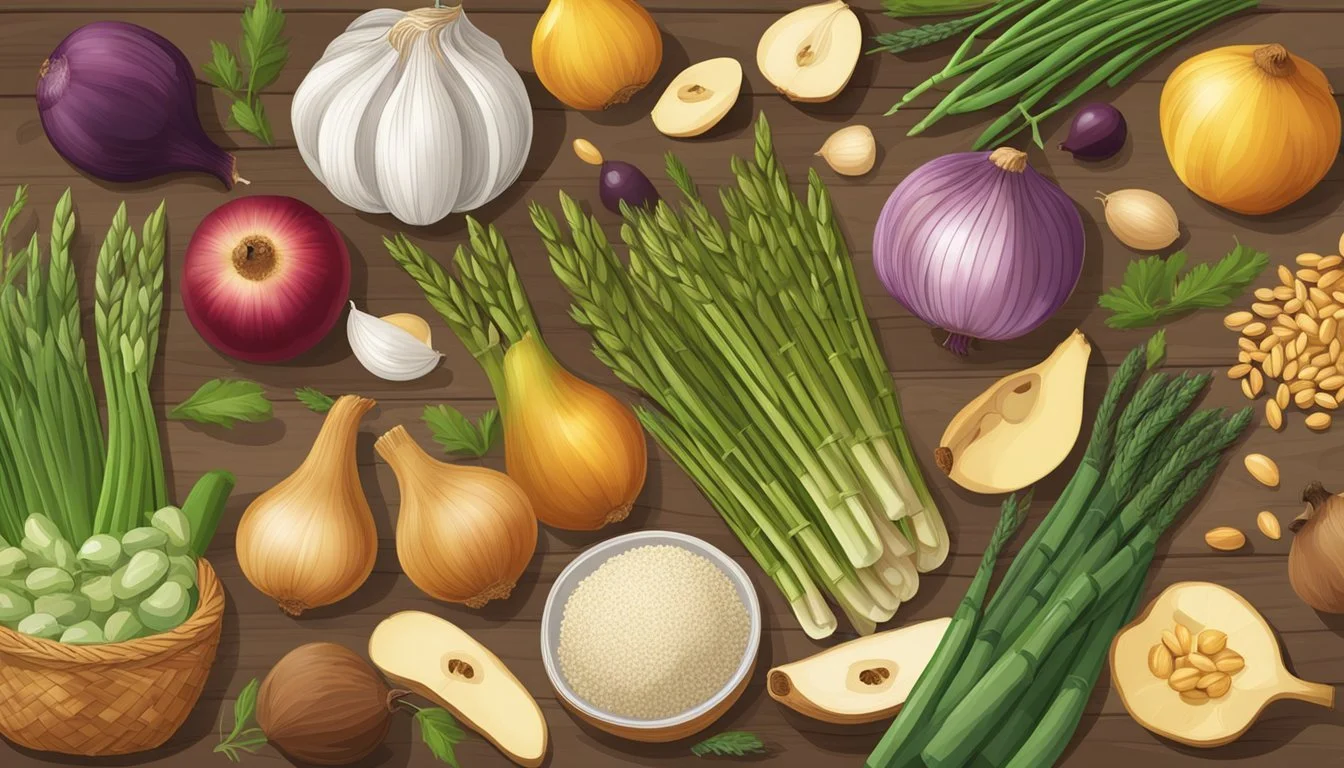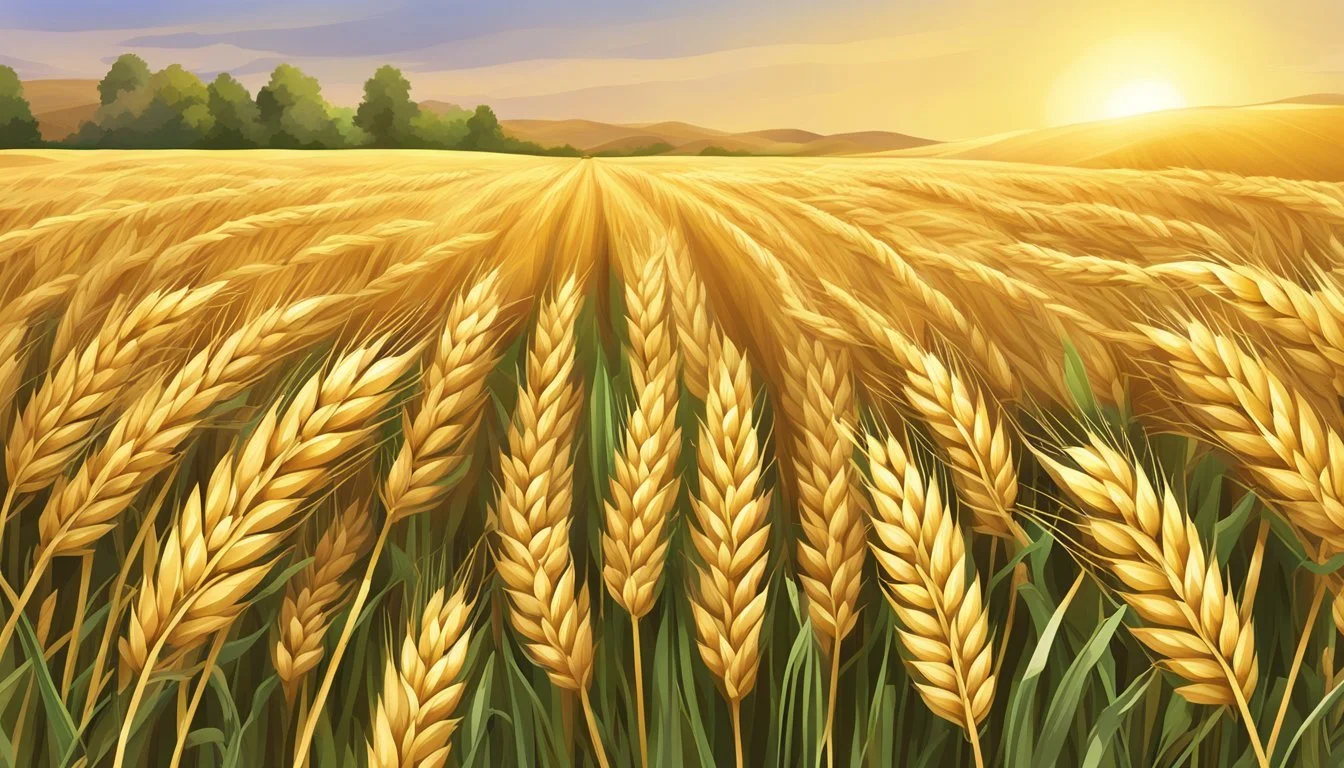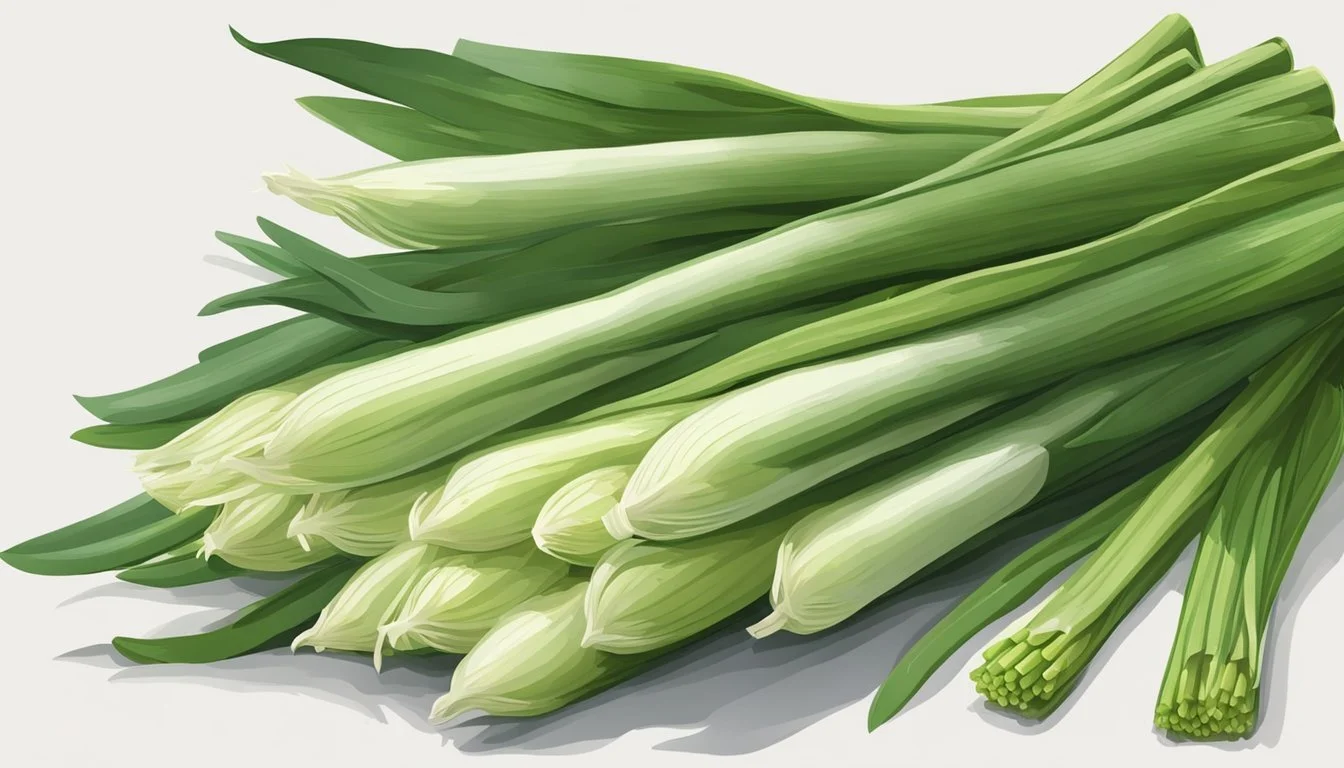Understanding Fructan-Rich Foods
Understanding Their Impact on Your Diet
Fructans, a type of carbohydrate, are found in a variety of foods and can have significant effects on digestive health. They are part of the larger group of FODMAPs, which are known to cause issues for individuals with certain sensitivities or conditions such as Irritable Bowel Syndrome (IBS). Why should people be aware of foods high in fructans?
Knowing which foods contain high levels of fructans is essential for those looking to manage symptoms like bloating, gas, and other gastrointestinal discomforts. Many might not realize that common foods they consume daily are high in fructans and could be contributing to their symptoms.
1) Garlic
Garlic is a common kitchen staple known for its strong flavor and numerous health benefits. It is also high in fructans, a type of carbohydrate that can cause digestive issues for some people, especially those with irritable bowel syndrome (IBS).
Fructans in garlic are a form of oligosaccharide, which humans cannot digest easily. These carbohydrates pass through the small intestine and reach the colon, where they ferment and produce gas.
Garlic contains more fructans than many other foods, making it particularly problematic for those who are sensitive to these compounds. This includes raw garlic, black garlic, and garlic powder.
Cooking garlic does not significantly reduce its fructan content. Even if you remove garlic cloves before serving a dish, the fructans can still leach into the water or oil used during cooking, thereby remaining in the food.
For individuals following a low-FODMAP diet to manage IBS symptoms, avoiding garlic can be challenging due to its prevalent use in cooking. Alternatives such as garlic-infused oil can provide the flavor without the adverse effects.
It is important for those sensitive to fructans or managing IBS to be vigilant about garlic in their diet to avoid gastrointestinal discomfort.
2) Onions
Onions are a common vegetable known to be high in fructans. Fructans are a type of carbohydrate that can be challenging for some individuals to digest.
The presence of fructans in onions can lead to digestive issues such as bloating and gas, especially in people with irritable bowel syndrome (IBS).
Onions come in various types, including red, white, and yellow. All varieties contain high levels of fructans, making them a significant source of this carbohydrate.
Cooking onions, whether by sautéing, baking, or boiling, does not reduce the fructan content substantially. Therefore, even cooked onions can cause discomfort in fructan-sensitive individuals.
Raw onions, often used in salads and garnishes, may have a more pronounced effect on digestion due to their high fructan content.
For those needing to avoid fructans, it may be advisable to limit or eliminate onions from their diet. Alternatives like chives or the green tops of scallions can be used as lower-fructan substitutes.
These substitutions can provide a similar flavor profile without the associated digestive discomfort.
3) Wheat
Wheat is a significant source of fructans in many diets. It is commonly found in staple foods like bread, pasta, and cereals. Because of its high fructan content, wheat can cause digestive discomfort for individuals sensitive to these compounds.
Foods made from wheat, such as whole wheat bread, wheat flour, and wheat-based snacks, contain substantial amounts of fructans. This makes them a major concern for those with fructan intolerance or irritable bowel syndrome (IBS).
It's important to note that while gluten is often mentioned alongside fructans, the two are different. Gluten is a protein, while fructans are a type of carbohydrate. Many high-gluten foods also have high levels of fructans, which can lead to confusion about the root cause of gastrointestinal symptoms.
Including or avoiding wheat in the diet depends on individual tolerance levels. For those managing fructan sensitivity, substituting wheat with low-fructan grains like rice or quinoa can help reduce symptoms.
4) Rye
Rye is a cereal grain that is commonly found in bread, beer, and various other baked goods. It is especially notable for its high fructan content.
Fructans are a type of carbohydrate that can cause digestive issues for some people. Rye contains approximately 4.2 grams of fructans per 100 grams of unprocessed grain. This makes it a significant source of fructans in many diets.
Rye is also known for its dense texture and slightly sour taste, making it a popular choice in many traditional recipes. It is used in products like rye bread and crispbread, which are staples in certain cultures.
People with fructan intolerance should be cautious when consuming rye. Even small amounts can trigger symptoms. For those managing such intolerances, it is beneficial to seek out alternatives with lower fructan content.
Despite its potential to cause discomfort in some individuals, rye offers nutritional benefits. It contains fiber, vitamins, and minerals. However, its high fructan content often outweighs these benefits for people with sensitivities.
5) Barley
Barley is a cereal grain known for its high fructan content. It is commonly used in various food products and beverages due to its nutritional benefits and versatility.
This grain is a significant source of dietary fiber, providing essential nutrients and aiding in digestion. It can be found in soups, stews, bread, and malt beverages.
For individuals with fructan intolerance, consuming barley can lead to symptoms such as bloating, gas, and stomach discomfort. It is important for these individuals to be aware of barley's presence in foods to manage their symptoms effectively.
Barley also contains gluten, making it unsuitable for those with celiac disease or gluten sensitivity. This dual challenge requires careful dietary planning for people with these conditions.
Products like barley flour and barley malt extract are commonly used as ingredients in processed foods. These can be a hidden source of fructans, emphasizing the need for consumers to read food labels thoroughly.
6) Leeks
Leeks are a commonly used vegetable in many culinary dishes. They consist of two main parts: the green leaves and the bulb.
The green leaves of leeks are safe for people following a low FODMAP diet and can be consumed without restriction.
The bulb of the leek, which is the white or light green part, contains high levels of fructans.
Fructans belong to the category of oligosaccharides in the FODMAP acronym.
Due to their fructan content, the leek bulb may trigger symptoms in individuals with IBS or fructan intolerance.
When using leeks in cooking, it's recommended to use only the green leaves if you need to avoid high-FODMAP foods.
Avoiding the bulb can help prevent gastrointestinal discomfort associated with fructan intolerance.
Leeks add a mild, onion-like flavor to dishes and can be a versatile addition to soups, salads, and stir-fries.
By focusing on the green leaves, individuals can still enjoy the unique taste of leeks without exacerbating IBS symptoms.
7) Asparagus
Asparagus ranks high among vegetables rich in fructans. These natural fibers can be problematic for individuals with fructan intolerance.
The fiber content in asparagus can lead to fermentation in the gut. This process results in symptoms like bloating and discomfort.
Cooking methods can influence the fructan levels. Lightly steaming or boiling may reduce these symptoms for some people.
Asparagus offers nutritional benefits despite its fructan content. It provides essential vitamins and antioxidants.
People with fructan intolerance might need to limit or avoid asparagus. Talking to a healthcare provider can help determine suitable dietary adjustments.
8) Artichokes
Artichokes are a vegetable known for their high fructan content. They can be a delicious addition to many dishes, providing both flavor and nutritional benefits.
Fructans, a type of carbohydrate, can be difficult for some people to digest. This is particularly true for individuals with irritable bowel syndrome (IBS) and fructan intolerance.
Despite their fructan content, artichokes are rich in vitamins, minerals, and antioxidants. They offer nutrients like vitamin C, vitamin K, folate, and magnesium, making them a healthy vegetable to include in the diet.
However, for those sensitive to fructans, consuming artichokes may lead to digestive discomfort. It is advisable for these individuals to monitor their intake and assess their tolerance levels.
Artichokes can be prepared in various ways, such as steaming, grilling, or baking. Their unique flavor pairs well with a wide range of ingredients, enhancing the culinary experience. Adjusting preparation methods may help reduce fructan content for better tolerance.
9) Chicory Root
Chicory root is a prominent source of fructans, specifically inulin, a type of prebiotic fiber. This root is commonly used as a coffee substitute or additive due to its robust, earthy flavor. It not only enhances gut health by promoting the growth of beneficial bacteria but also offers additional health benefits.
Inulin from chicory root helps improve digestion by increasing the frequency and bulk of stools. This makes it beneficial for those dealing with constipation. The presence of prebiotics supports the absorption of minerals like calcium and magnesium, which are crucial for bone health.
The high inulin content also aids in regulating blood sugar levels. This is particularly important for people managing diabetes. Moreover, chicory root's ability to modulate gut flora can help in reducing inflammation and improving immune function.
Chicory root can be incorporated into the diet in various forms, including roasted as a coffee alternative or ground into a powder for supplements. It’s also found in many processed foods as a fiber additive due to its beneficial properties and neutral taste.
10) Fennel
Fennel is a vegetable known for its distinct licorice-like flavor. It is commonly used in culinary dishes and consumed both raw and cooked.
Fennel bulb, in particular, is high in fructans. These are a type of carbohydrate found in various foods that can trigger digestive discomfort in some individuals.
Fructans in fennel can cause symptoms such as bloating, gas, and stomach pain for those with a fructan intolerance or sensitivity. This is due to the fermentation process that occurs in the gut.
People following a low-FODMAP diet may choose to avoid fennel to manage their symptoms. It's essential for these individuals to monitor their reactions and adjust their diet accordingly.
Incorporating alternative vegetables can provide similar nutrients without the adverse effects of fructans for those affected.
What Are Fructans?
Fructans are a type of carbohydrate, specifically a chain of fructose molecules. They are found in a variety of foods and can cause digestive issues for some individuals.
Chemical Structure
Fructans are composed of multiple fructose units linked together. They can form chains of varying lengths, sometimes including a glucose unit at the end. These oligosaccharides are part of the FODMAP family, known for being poorly absorbed in the small intestine.
Structurally, fructans differ from other carbohydrates because they are not easily broken down by human enzymes. Instead, they reach the colon intact, where they are fermented by gut bacteria. This fermentation process can create gas and other byproducts, leading to digestive discomfort in sensitive individuals.
Sources of Fructans
Fructans are present in a wide range of foods. Common sources include vegetables like artichokes, asparagus, and garlic. Many grains such as wheat, rye, and barley also contain high levels of fructans. Fruits like bananas and some types of apples have smaller amounts.
For those managing fructan intolerance, it is recommended to avoid foods high in these carbohydrates. Dietary adjustments can help alleviate symptoms, and guidance from a healthcare provider can be valuable. A list of high-fructan foods may include certain vegetables, grains, and even some processed foods containing inulin or other fructan-based additives.
Health Implications of High Fructan Foods
High fructan foods can impact health significantly, mainly affecting digestive health and triggering intolerance in some individuals. They also offer potential health benefits such as immune system modulation.
Digestive Issues
High fructan foods can cause digestive issues for many people. Fructans are a type of carbohydrate that is not easily digestible. When these foods reach the colon, they are fermented by bacteria, which can lead to the production of gas and bloating.
Common symptoms include abdominal pain, flatulence, and diarrhea. Fructans are part of the FODMAP group of carbohydrates that can lead to Irritable Bowel Syndrome (IBS) symptoms. Reducing high fructan foods might alleviate these digestive problems.
Fructan Intolerance
Some individuals may be more sensitive to fructans, experiencing symptoms similar to gluten sensitivity or lactose intolerance. People with fructan intolerance may struggle to digest high fructan foods, leading to issues such as bloating, gas, and abdominal discomfort.
A fructan elimination diet can help determine if someone has an intolerance. Removing fructan-rich foods for a few weeks and then reintroducing them can show if symptoms improve without these foods in the diet.
Potential Benefits
Despite potential digestive challenges, high fructan foods do offer health benefits. Fructans can act as prebiotics, supporting the growth of beneficial gut bacteria. This can enhance overall gut health and improve immune function.
They might also have antioxidant properties, helping to reduce oxidative stress in the body. Including moderate amounts of high fructan foods such as onions, garlic, and asparagus, when tolerated, can contribute to a balanced diet that supports health.





